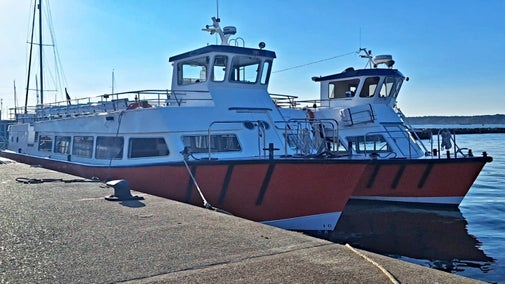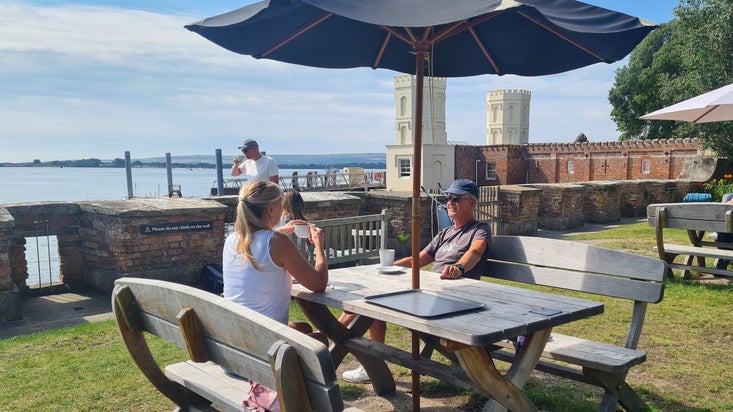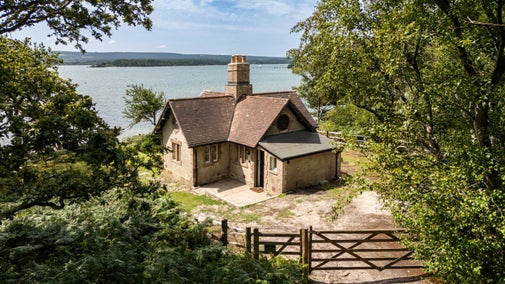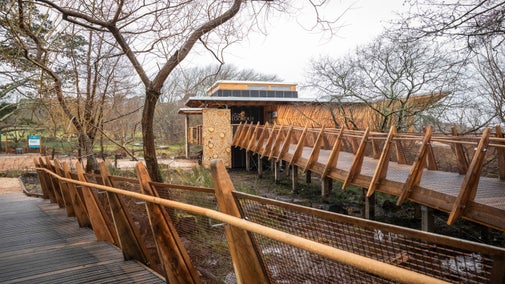Brownsea Island
Famous for red squirrels, wildlife and Scouting
Poole Harbour, Poole, Dorset, BH13 7EE

Important notice
Opening times for 9 May 2025
Asset Opening time Outdoor Centre campsite Open all day Countryside 10:00 - 17:00 Villano Café 10:00 - 16:45 MTWTFSS282930123456789101112131415161718192021222324252627282930311OpenPartially openClosedBrownsea Island admission (from 15 March)
Ticket type With Gift Aid Without Gift Aid Adult (18+) £11.00 Child (5-17) under 5s free £5.50 Family (2 Adults and up to 3 children) £27.50 Group (Adult 18+) £10.50 Group (Child 5-17) £5.00 1 adult + 3 children £16.50 Become a member and discover more than 500 places
- Adventure playground/play area
Red squirrel-inspired agility course featuring balance beams, climbing frame, obstacles, see-saw and den-building area.
Adventure playground/play area - more information- Assistance dogs only
Dogs are not permitted on Brownsea Island, with the exception of assistance dogs which must be clearly identifiable.
- Bookshop
Please visit our Engine Room for our second hand bookshop.
- Café
The Villano Café has indoor and outdoor seating & serves light snacks, hot & cold food & drinks & ice cream. There is also a snack van, with seasonal opening at the Outdoor Centre offering snacks, refreshments & ice cream. Refill your water bottles at the Café and campsite, don't forget to bring your reusable cup for 25p off your takeaway hot drink.
Café - more information- Family friendly
The family adventure starts on the boat over, upon arrival there are lots of trails to follow. Free events run over the school holidays, kids can let off steam at the natural play area. Nature loving families can look out for the famous red squirrels and watch the birds from the hides on the lagoon.
Family friendly - more information- Guided tour
Introductory walks and Squirrel Shuttle mini-bus tours are available subject to volunteer availability. Please enquire at reception on arrival.
Guided tour - more information- Toilet
Toilets are available at the Courtyard, Visitor Centre and at the Outdoor Centre.
Some slopes and uneven ground. Pre-bookable wheelchair friendly ferry service, all-terrain manual wheelchairs available to hire and our Squirrel Shuttle mini-bus offering tours and a hop on/ hop off service.
- Accessible route and/or map
Brownsea Island Access Map
Accessible route and/or map - more information- Accessible toilet
Accessible toilet facilities are available at the Courtyard, Visitor Centre and Outdoor Centre.
- Induction loop
Induction loop at Visitor Reception and in the Villano Café.
- Large print (guide or menu)
Available on request.
- Level access to food outlet
- Level access/terrain
- Photograph album
Available via the guided mini-bus tour.
- Ramped access/slopes
- Seating available
- Steps/uneven terrain
- Transfer available
The Brownsea Seahorse landing craft is available to book as an alternative for visitors who are unable to access the island on the passenger service from Poole Quay. To book a Seahorse transfer to and from the island please contact us brownseaisland@nationaltrust.org.uk or call 01202 707744.
Transfer available - more information- Virtual tour
There is also a BSL history tour, maps available from Reception.
Virtual tour - more information- Wheelchairs available
Limited number of all-terrain manual wheelchairs available to pre-book on 01202 492164.
- By road
For the ferry from Poole Quay to Brownsea: Follow signs to Poole Quay. To access Poole Harbour from the west take the A35/A350 Dorchester-Poole route. From the east take the A31 Ringwood-Poole road. From the north take the A3081/A350 Shaftesbury-Poole road.
Parking: Parking in Poole: follow signs to Quay Visitors car park (BH15 1SB). For vehicles 1.90m+ use surface car parks at Baiter a 15 minute walk to the Quay (BH15 1UX). There is parking available at The Thistle Hotel car park, but please note that the hotel is not in use just the parking. You’ll need to download the Evology parking app in advance https://evologyparking.com/
Sat Nav: Poole Quay: BH15 1HP (for parking for Poole Quay use postcode in parking section).
- On foot
To Poole Quay: From the Quay visitors car park in Poole: follow the pedestrian signage to Poole Quay where you will find ferries departing to Brownsea Island (BH15 1HJ).
- By train
Poole Railway Station is 0.5 miles from Poole Quay. The Poole Town circular bus connects to the Quay from the train station. For bus information visit: https://www.morebus.co.uk/services
- By bus
The Poole town circular bus connects Poole Quay with the bus and train station. The number 60 runs from Rockley Park to Poole Quay. The numbers 8 and 9 run services close to Poole Quay via Hamworthy, Turlin Moor, Upton and Creekmoor. Available from April 2025 - New BCP multitrip bundle offers 10 single bus trips in zone A (Poole) for £20 working out at £2 per journey. This offer can be found on the Morebus App https://www.morebus.co.uk/app
- Cycling
Please note that it's not possible to bring bikes to the island.
The following directions will give you the best routes to the ferries and information about where to store your bike.
National Cycle Network route 25 runs from Blandford Forum to Bournemouth, via Wimborne Minster and Poole Quay.
Poole has dedicated cycle lanes through the town and there are traffic free routes across Poole Park.
For bike storage the Dolphin Centre in Poole has a cycle hub with 29 spaces, including storage for eBikes and Cargo bikes, for more information visit https://www.spokesafe.com/dolphin-cycle-hub. Cycle racks are also available at Poole Quay.
The Beryl bike scheme has a parking bay nearby, visit Beryl Bike Scheme for more information. www.beryl.cc/scheme/bournemouth-christchurch-and-poole
- By ferry
Access to Brownsea Island is via ferry. All 2025 information on getting here from Poole Quay is available on our website.
- Seahorse landing craft
The National Trust's Seahorse landing craft can transport visitors using wheelchairs, quickly and safely to the island. This service is pre-bookable only, and tide dependent. Pick-up location is from the Sandbanks Yacht Company slipway and it's an easy 10-minute journey to the island. The service is weather dependent, so to check out sailing times and prices, please see the 'Accessible Brownsea' section of the website email brownseaisland@nationaltrust.org.uk or call 01202 707744.
Planning your visit

Visiting Brownsea Island from Poole Quay
In this article you'll find all you need to know to plan your visit to Brownsea, including how to get here by ferry.

Accessible Brownsea
To ensure as many people as possible can enjoy the island, discover how we're making Brownsea accessible to all.

Visiting Brownsea Island with a group
Brownsea Island is a popular destination for groups, so we've put together this article to help you plan your day, with information on how to book your visit.

Events at Brownsea Island
Search our upcoming events including seasonal trails, walks as well as other opportunities to experience Brownsea Island out of hours.

Visiting Dorset Wildlife Trust
National Trust members and non-members may also visit the Dorset Wildlife Trust (DWT) area on Brownsea Island. A suggested donation of £2 applies if you're not a member of DWT. If visiting as a DWT member and you wish to explore the National Trust area, you'll need to pay the National Trust admission fee.
Highlights
Ferry trip
Your Brownsea adventure starts with a ferry trip. Head to the ‘Planning your visit’ section for information on getting here from Poole Quay
Wildlife haven
Famous for red squirrels, the island's habitats include heathland, woodland and a lagoon – internationally important for overwintering and summer-nesting birds.
Historic campsite
At the birthplace of Scouting an overnight adventure awaits. Scouts, Guides, seasoned campers and comfort-seekers can pitch up, book a bell tent or hang out in a tree tent.
Natural play area and free trails
Red squirrel-inspired agility course featuring balance beams, climbing frame, obstacles, see-saw and den-building area. Free family trails available from the Visitor Centre and Outdoor Centre.
Daily guided tours
Offered daily, subject to volunteer availability. Hop on one of the Squirrel Shuttle mini bus tours designed for those less-abled or people wanting to explore the further reaches of the island. Booking advised 01202 492164.
Visitor Centre and Engine Room
Visitor Centre: Discover red squirrel stories and lift the lid on Brownsea's wildlife. Engine Room (near reception): meet the characters that have shaped Brownsea and browse our second-hand bookshop.
Villano Café and Trading Post
Harbourside café serving hot and cold drinks, lunches, cakes and ice cream. Snack van (seasonal) at the Outdoor Centre where you’ll also find island souvenirs at the Trading Post.
Boat, kayak and paddleboard access
Head to the island via your own boat, kayak or paddleboard and we welcome you to land along the South Shore only. No landing along the North Shore or sea wall due to nesting birds, or at the National Trust pier for safety.
Spotlight events

Wild wetland bird walks
Brownsea Island is a haven for bird enthusiasts and nature lovers alike. Our guided walks, led by an expert Dorset Wildlife Trust Ranger, take you through the island's vibrant wetlands, where the Brownsea Lagoon stands as a premier birdwatching destination in England. The lagoon's shallow, nutrient-rich waters draw in thousands of birds annually, creating a dynamic and ever-changing avian spectacle. Each walk is a celebration of the seasonal bird phenomena that make Brownsea so special. From the bustling spring migrations to the tranquil winter gatherings, you'll witness the incredible diversity of birdlife that calls this island home. After your birdwatching adventure, relax with a light bite at the harbour-front café. Then, continue your exploration of Brownsea's natural wonders, including the elusive and enchanting red squirrels. A voucher for a pasty and drink is included in the ticket fee.

Poo-tastic activity trail
Join us on a unique and quirky trail dedicated to animal droppings. Have fun with various activities as you learn some poo-mazing facts. In the wild, animals see poo as something valuable – it can be used, reused, recycled, and even played with. Have a go at our fun games like cow pat frisbee, roll balls like a dung beetle, and try to identify the poopetrator. It’s an adventure that’s sure to be a hit with the whole family. The trail is open from 25-31 May from 10-5. This event is free, but normal admission charges apply for the island.

Open-air theatre on Brownsea Island
This year we introduce two exciting new Shakespeare troupes who will be performing on Brownsea over the summer. The Handlebards troupe travel by bike and have won several sustainability awards. They have a charming, funny approach to Shakespeare plays and will be performing Much Ado About Nothing. Three Inch Fools productions are inventive, fast-paced and they will be using music to bring to life A Midsummer Night's Dream. Bring your friends and family for an unforgettable evening of theatre in one of the UK's most beautiful settings.
Things to see and do

Family adventures on Brownsea Island
Plan your family-friendly visit to Brownsea Island. From seasonal trails to the natural play area, discover things to do for all the family.

Wildlife watching on Brownsea Island
Take a walk on Brownsea Island, Dorset, and encounter a variety of birds and other wildlife that calls this island sanctuary in Poole Harbour, home.

Outdoor activities at Brownsea Island
There's many ways to experience Brownsea Island, Dorset. From accessing the island via kayak, boats or paddleboards, to camping, beachcombing and special out-of-hours events.
Top trails

Brownsea Island viewpoint vistas walk
Enjoy a scenic tour of Brownsea Island’s best viewpoints, offering spectacular seascapes that take in neighbouring islands and the Purbeck Hills beyond. Make sure you bring your camera.

Brownsea Island wildlife walk
There is plenty of wildlife and history to discover on this woodland walk. Catch a glimpse of a rare red squirrel or traces of Brownsea's once industrial past.
Eating and shopping

Eating and shopping on Brownsea Island
Fuel up for your adventure at the Villano Café, where you'll find a wide variety of hot and cold drinks, snacks and light meals. Elsewhere, shop for a Brownsea Island souvenir at the Trading Post and browse our second-hand bookshop.
Places to stay

Brownsea Island campsite
Ever wondered what the island is like after all the day visitors have gone home? Stay overnight on the campsite and explore the island, spotting swooping bats, churring nightjars and luminous glow-worms.

Discover more with the National Trust Podcast
Camp under the trees at Brownsea Island, Dorset and uncover the history of the Scouts movement in 'Escape to adventure island'. You can also find more episodes from series seven, filled with nature and history.

St Mark's Bothy
A rustic stone bothy near the shore on Brownsea Island, with simple facilities and sea views.

South Shore Lodge
Perfectly placed for sea views and island adventures.

Agent's House
Sitting on Brownsea Island, with stunning sea views and the chance to spot a red squirrel or two.

Custom House
A bright and contemporary newly-converted cottage right at the water’s edge on Brownsea Island.
Upcoming events
Historical guided walk with cream tea in Brownsea Castle.
Step back in time with our exclusive history-guided walk, featuring special access to the enchanting Brownsea Castle.
Wild wetland bird walk
Experience the avian marvels of Brownsea Island with our guided birdwatching walks. Led by a knowledgeable Dorset Wildlife Trust ranger, explore one of England's top birdwatching sites, the Brownsea Lagoon.
Poo-tastic activity trail
Join us on a unique and quirky trail dedicated to animal droppings. Have fun with various activities as you learn some poo-mazing facts.
Way of the wild - Bushcraft taster sessions
Dive into the wild and master survival skills at the birthplace of the scouting movement. Join Joe Peartree, our expert bushcraft specialist, for a unique, hands-on experience.
Evening echoes: bird and bat safari on Brownsea Island
Set sail on the Dorset Queen for an unforgettable evening adventure to Brownsea Island. As you savour a classic fish and chips meal, the peaceful waters will carry you to this natural haven in time for your twilight safari.
HandleBards Open Air Theatre - Much Ado About Nothing
Join the HandleBards on Brownsea for an evening of open-air theatre. Enjoy Shakespeare's "Much Ado About Nothing" with laughter, romance, and magic. Bring a picnic and friends for an unforgettable experience in a stunning setting
Summer Solstice Yoga on Brownsea Island.
Celebrate the longest day of the year with a magical Summer Solstice yoga experience on Brownsea Island. Enjoy a peaceful and unforgettable evening surrounded by nature.
Reconnect with nature: Forest bathing experience
Experience the calming embrace of nature with our forest bathing sessions on Brownsea Island. Guided through calming woodlands, you'll find peace and rejuvenation in this natural sanctuary.
About Brownsea Island
Brownsea Island is dramatically located in Poole Harbour, with spectacular views across to the Purbeck Hills.
Thriving habitats including woodland, heathland and a lagoon create a unique haven for wildlife, such as the rare red squirrel and a wide variety of birds, including dunlin, kingfishers, common and Sandwich terns and oystercatchers.
Free trails help you explore the island, there is a natural play area and fantastic picnic spots, an island adventure waiting for the whole family.
Our work
Brownsea Island Countryside Stewardship project
This is one of the largest conservation projects in Brownsea Island’s history, to create better conditions for nature to thrive and provide a sustainable future for the conservation of species dependent on Brownsea's varied habitat.
Sandbanks Jetty project: Brownsea Island
Out with the old, and in with the new. Find out about the plans for a new jetty at Sandbanks.

Supporting Brownsea's young wildlife
Discover how a team from the National Trust support the woodland residents on Brownsea Island, Dorset.

The Lookout on Brownsea Island
Find out about The Lookout a new wildlife observatory on Brownsea Island with stunning views across the lagoon.

History of Brownsea Island
Discover the stories of Brownsea Island through the years from medieval to modern and meet some of the characters that have helped shape the island's history.

Brownsea Island is now the leading place where adventure meets conservation
We’ve joined with the Dorset Wildlife Trust and other landowners, to create the largest lowland heath National Nature Reserve for a more joined-up approach to nature conservation.

Sustainable Business Award 2024
We are very proud to have been awarded a level 6 Sustainable Business Award for nature recovery in 2024 from Dorset Council.
Support us

Volunteering and community work on Brownsea Island
Volunteers are vital in supporting special places such as Brownsea Island.